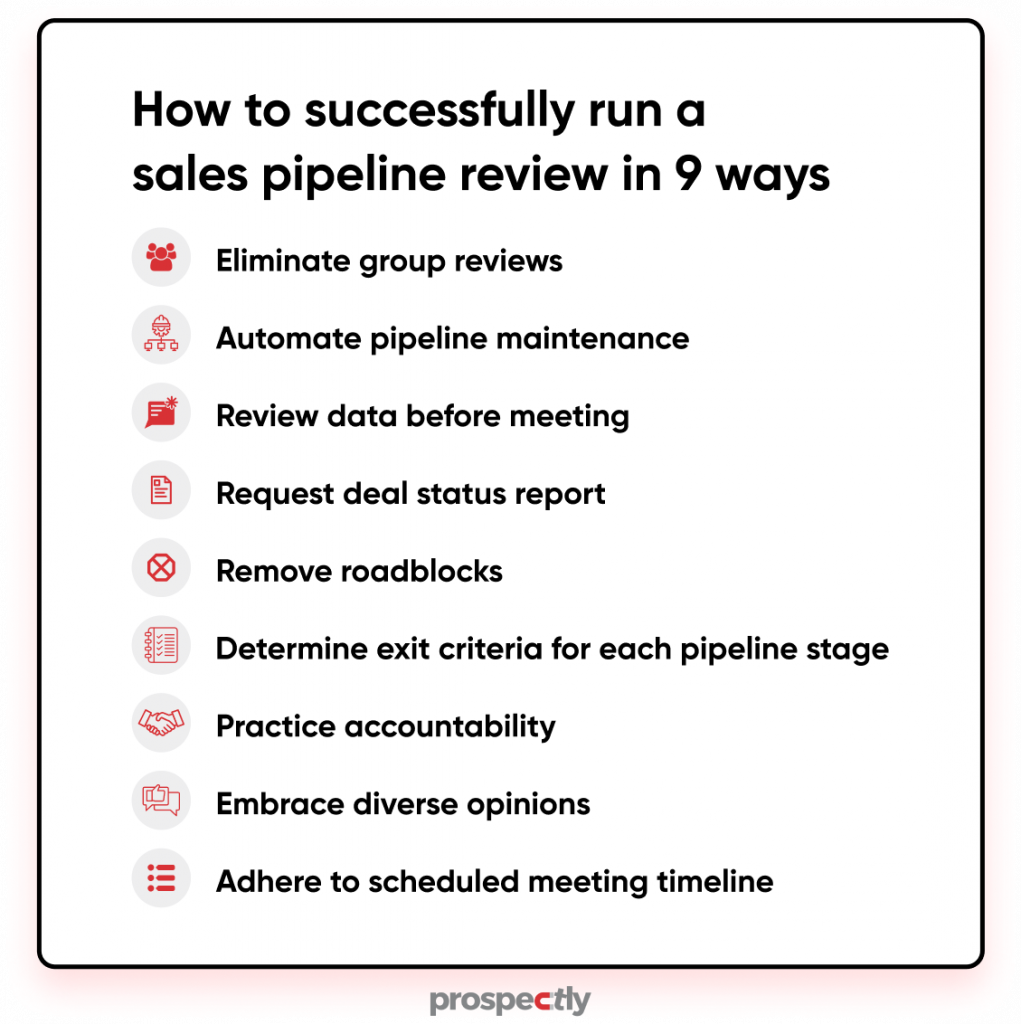9 Easy ways to make your sales pipeline review a success

A sales pipeline review provides a complete overview of your pipeline. It’ll help you focus your efforts to ensure your business meets its goals. Managers need to effectively run a pipeline review meeting to keep salespeople motivated and raring to go. Poorly managed discussions can be time-wasters and lead to loss of productivity. Find out how to conduct a successful sales pipeline review session in nine easy strategies.
Let’s start by refreshing your memory about the pipeline.
What is a sales pipeline?
A sales pipeline is a graphical representation of a salesperson’s process when selling something. It typically starts with identifying potential prospects, followed by lead qualification, and then the opportunity to make a sale.
Reps can use it to track the progress of an individual prospect or lead as they move through each stage of the process. Sales leaders must organize meetings to review a pipeline.
Pipeline review definition
What is a sales pipeline review? A sales pipeline review is a strategic assessment of your current sales process. It’s an opportunity to identify and address the issues preventing you from closing more deals and identify areas for improvement.
The most common types of sales pipeline reviews are:
The Sales Pipeline Review: It looks at the deals in your pipeline and how they are progressing towards closure.
The Sales Pipeline Assessment: It assesses all the people involved in your sales process, from prospects to customers, and how they fit into your sales process.
The Sales Process Review: It reviews the processes you use to generate leads, qualify them, manage them through the buying cycle, close deals, and measure success.
In this blog, we’ll zero in on the sales pipeline review.
There are many benefits to conducting a sales pipeline review, including:
-Identifying potential issues in the sales process before they become big problems.
-Providing visibility into the status of each deal at any given point in time.
-Helping identify trends, patterns, and opportunities to improve performance on deals that are not going well.
-Providing an opportunity for management to give feedback on how their team is doing.
-Offering the team a chance to understand better how sales managers perceive them.
Pipeline review metrics

You can talk about the following metrics during the sales pipeline review.
- Number of qualified leads
- Number of scheduled meetings
- Number of demos booked
- Number of deals at the negotiation stage
The above numbers help you understand your MQL and SQL conversion rate. They represent prospects you can nurture and convert into buyers.
Related: “How to build a sales pipeline in 2022”
Who should participate in the review pipeline?

Sales pipeline review meetings should involve a sales manager, a salesperson, a senior executive member. Revenue operation team members can also participate in the sessions, such as customer success, sales, and marketing. And they can help in many ways.
- Sales can inform the customer success and marketing teams of any unsuccessful deals.
- They can then create marketing campaigns to warm up the leads.
- Marketing can boost resources in regions with few pipeline opportunities.
Pipeline review framework

A framework can help you conduct a successful pipeline review. Here are some things to consider to create a pipeline structure.
Structure: You can review all the pipeline deals or concentrate on high-priority opportunities.
Frequency: Meetings can be weekly, biweekly, or monthly.
Duration: A pipeline review meeting can last between 30-60 minutes.
Size: You can have 1-on-1s, rotational, or group pipeline review meetings.
Action: At the end of the session, each salesperson needs to know their actionable items. For example, they can focus on refining their closing techniques.
How to successfully run a sales pipeline review in 9 ways

1. Dump a group pipeline review meeting
Reviewing a pipeline with the entire team has some challenges. Gretchen Gordon is the owner of Braveheart Sales Performance – a consulting company. She insists that managers should do away with group pipeline reviews because they’re wasteful, boring, and useless.
Here are more reasons:
- It’s time-consuming since your sellers have to prepare reports and slides for presentation during the meetings. Instead, they could use this time to chase prospects or sell more products.
- It makes sales reps believe that they must focus on a big pipeline.
- As a result, they concentrate more on filling up the pipeline to impress the sales manager.
- Salespeople pay little attention to what you say during team sessions. You may want to use this time to offer sales tips to the entire team on stalled deals. But this coaching could be unsuccessful due to a lack of concentration.
What should you do instead? Check out the following suggestions.
- Stop using team pipeline reviews immediately. However, they could be necessary if several salespeople are involved in one sale. Managers can have a group pipeline review to strategize and solve problems as a team.
- Talk with each seller one-on-one about their sales pipeline and velocity of deals. Also, reps should tell you about every pipeline deal’s agreed course of action.
- Inform them to stop fluffing up the pipeline – they must take the deal forward or leave it and move on.
- See the pipeline as a predictive tool: Work out the number of dollars or deals that you need in your pipeline for each rep to hit their goals. Next, ensure that they fill the pipeline with high-quality deals.
- Direct your salespeople’s efforts on activities that help them crush their numbers, e.g., the number of demos, discovery calls, etc.
- Use team meetings to fix organizational challenges, develop strategies to win targetted prospects, share best practices, and role-play.
2. Automate pipeline maintenance
Pipeline reviews need up-to-date data to enable managers and sellers to check the status of leads accurately. Resource reps with CRMs software with AI capabilities to reduce manual data entry and human errors. These tools can automatically capture a salesperson’s emails, notes, calls, scheduled demos, and meetings.
Also, managers should ensure they’ve got the same data that reps have in their CRM dashboard to see the crucial leads in the pipeline. Always remind sellers to have the correct stats.
3. Examine the CRM data before the meeting
Salespeople, managers, and sales leaders should review the latest data regarding the pipeline well in advance. They need to prepare questions, too. As a result, everyone forms an opinion beforehand and knows what they need to do and fix the challenges.
Also, meetings become conversational instead of being interrogative. CRM software improves your pipeline reviews in more ways, including:
Establishing targets: You can create targets for your salesforce, such as the number of deals, sales qualified leads, meetings, and the pipeline value.
Monitoring metrics: CRM dashboards keep you in the loop about average deal value, deals in the pipeline, deal closures, etc.
Sales forecast: CRM data regarding your pipeline shows the accurate record of deals that are likely to close and forecasted cash flow.
4. Request a brief report of the deal
Ask the seller to update you by providing feedback on the deal. Consider the following aspects.
- What’s the current status of the deal?
- What do they plan to do next?
- What should they do to close the sale?
- When do they expect to bring the sale to a close?
As you listen to the summary, you’re likely to note roadblocks to the deal.
5. Clarify the obstacles and challenge the salesperson
You need to be clear on the possible hurdles that can prevent the deal from closing. Here are some things to consider to identify the snags.
- Does communication seem to be lacking?
- Does any information need to be added?
- What has your rep done so far to handle objections?
- What’s holding up this deal from closing?
After this discussion, spell out the specific action items the seller needs to concentrate on to move the deal. Examples include handling an objection, contacting a person in authority, or abandoning the deal altogether.
Also, avoid turning sales pipeline reviews into forecasts, lengthy coaching sessions, in-depth strategy discussions, training modules, and updates about your company.
6. Explain when reps should move a deal
Salespeople and their managers need to agree on the exit criteria at each pipeline stage. It prevents confusion about the status of a lead and what sellers must do. Reps can ask several questions for each stage to determine if a lead is ready to take the next step in the pipeline.
Say a salesperson wants to know if they can move a prospect to the demo stage from qualification. They can ask the questions below.
- How has the lead defined the application’s uses in their organization?
- Can the company use the product if it meets its technical requirements?
- Can the company afford this product?
Sales reps can do this for other pipeline stages to establish a system outlining what they must do at each step.
7. Make everyone accountable
Accountability for managers and sellers is vital to ensure a follow-up to agreed items. Sales leaders can engage sellers by email or phone at the weekend to find out about the team’s progress. Or managers can use their CRM tool to track results.
Checking on the salesperson or viewing the CRM dashboard provides you with real-time data about leads. You can give feedback to your team and ask crucial questions on sluggish deals.
8. Allow a free discussion
There’ll likely be different views regarding particular situations about your pipeline. That’s because every stakeholder in the sales pipeline review sees things from their experience and understanding. Accept that there is no right or wrong answer-be open to other viewpoints and solutions.
9. Create and stick to the plan
A sales pipeline review agenda may have the following structure.
Metrics review
You can begin the meeting by summarizing the crucial metrics and opportunities.
Establish goals and targets
Talk about the activities reps need to perform to ensure a healthy pipeline. Also, identify opportunities salespeople should create to crush their numbers.
Pipeline review feedback
- Report on pipeline progress since the last meeting and follow up on the previous pipeline review
- Check on all current high-priority deals that are currently in the pipeline.
Wins
Recognize successes, such as deals closed to motivate your reps.
Challenges
Identify the obstacles and strategize how you can overcome them.
Action items
Highlight all the important deals and change them into action items.
Salesforce suggests running your meeting based on the structure below to enable you to deal with several leads.

It’s vital to stick to the schedule to avoid boring your salespeople to death and losing focus.
After the pipeline review
Your sales pipeline review could have the following outcomes.
- The sales team is well-informed and can proactively deal with its pipeline. It makes sellers stick to the sale process for all deals.
- The revenue operations team can determine if salespeople receive leads at the correct times. Also, it can figure out the velocity at which opportunities move through the sale cycle. A longer sales process may call for urgent remedial action, for example.
- The marketing team can redirect its efforts towards potential deals or ones at the risk of stalling.
Related: “Sales meetings: Best practice to run effective sales meetings in 10 minutes.”
In closing
A sales pipeline review is a process of assessing the current status of your sales pipeline and planning future actions to improve its performance. It’s an essential part of any sales process and can help you see where you are going wrong or improve your overall performance.
You should review your pipeline regularly. If you do it correctly, a sales pipeline can identify problems in the sales cycle that may not have been visible before. As a result, it helps you take corrective action before it’s too late.




